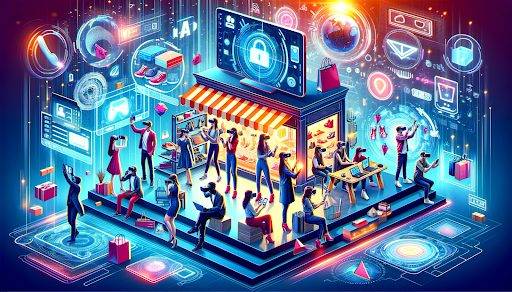In the rapidly evolving world of e-commerce, businesses are constantly seeking innovative ways to engage customers and enhance their shopping experiences. One of the latest and most promising trends is the rise of immersive experiences. By leveraging advanced technologies such as virtual reality (VR), augmented reality (AR), and 3D visualization, companies are transforming the online shopping landscape. This article explores why immersive experiences are becoming the new trend in e-commerce, the benefits they offer, and how businesses can effectively implement these technologies to stay ahead of the competition.

1. The Rise of Immersive Experiences
Immersive experiences use cutting-edge technologies to create realistic and engaging environments for users. These experiences are designed to mimic real-life interactions and provide a sense of presence that traditional e-commerce platforms cannot offer.
Virtual Reality (VR)
Virtual Reality (VR) technology immerses users in a fully virtual environment. By using VR headsets, customers can explore virtual stores, interact with products, and experience a more dynamic and engaging shopping journey. For instance, a customer can virtually walk through a clothing store, try on outfits, and see how they look from different angles, all from the comfort of their home.
Augmented Reality (AR)
Augmented Reality (AR) overlays digital content onto the real world, allowing customers to visualize products in their own environment. AR applications enable users to see how furniture would look in their living room, try on virtual makeup, or visualize how a new car would look in their driveway. This technology bridges the gap between online and in-store shopping by providing a more interactive and personalized experience.
3D Visualization
3D visualization provides detailed and interactive 3D models of products, giving customers a comprehensive view of the items they are considering. This technology allows users to rotate, zoom in, and examine products from all angles, enhancing their understanding and confidence in the purchase.
2. Benefits of Immersive Experiences in E-commerce
The adoption of immersive experiences in e-commerce offers numerous benefits for both businesses and customers. These benefits are driving the widespread adoption of these technologies across various industries.
Enhanced Customer Engagement
Immersive experiences captivate customers’ attention and encourage them to spend more time exploring products. The interactive nature of VR, AR, and 3D visualization makes the shopping experience more enjoyable and memorable, leading to increased customer engagement and higher conversion rates.
Improved Customer Confidence
One of the main challenges of online shopping is the inability to physically interact with products before purchase. Immersive technologies address this issue by providing a realistic and detailed view of products, helping customers make more informed decisions. This increased confidence reduces the likelihood of returns and enhances overall customer satisfaction.
Personalization and Customization
Immersive experiences allow businesses to offer personalized and customized shopping experiences. AR applications can recommend products based on the customer’s preferences and past behavior, while VR environments can be tailored to reflect the customer’s unique style and tastes. This level of personalization fosters a deeper connection between the customer and the brand.
Competitive Advantage
By adopting immersive technologies, businesses can differentiate themselves from competitors and position themselves as innovators in the market. Offering unique and engaging shopping experiences can attract new customers and retain existing ones, ultimately driving growth and profitability.
3. Implementing Immersive Experiences in E-commerce
Implementing immersive experiences in e-commerce requires careful planning and execution. Businesses need to consider several factors to ensure a successful integration of these technologies.
Investing in the Right Technology
Choosing the right technology is crucial for creating effective immersive experiences. Businesses should invest in high-quality VR headsets, AR software, and 3D visualization tools to provide customers with seamless and realistic interactions. Platforms like deovr.com provide comprehensive VR content management solutions that help businesses deliver high-quality immersive experiences to their customers. Collaborating with technology providers and experts can help ensure the successful deployment of these solutions.
Creating Engaging Content
The success of immersive experiences depends on the quality of the content. Businesses should focus on creating engaging and interactive content that showcases their products effectively. This includes developing realistic 3D models, creating immersive VR environments, and designing intuitive AR applications. High-quality content will enhance the overall user experience and drive customer engagement.
Integrating with Existing Platforms
For a seamless customer experience, immersive technologies should be integrated with existing e-commerce platforms. This includes ensuring compatibility with websites, mobile apps, and social media channels. Integrating immersive experiences with existing platforms allows customers to easily access and interact with the new features without any disruptions.
Providing Customer Support
As customers begin to use immersive technologies, they may require additional support and guidance. Businesses should provide comprehensive customer support to assist users in navigating VR environments, using AR applications, and exploring 3D visualizations. This support can include tutorials, FAQs, and dedicated customer service representatives to address any questions or concerns.
Conclusion
Immersive experiences are revolutionizing the e-commerce landscape by providing customers with more engaging, interactive, and personalized shopping experiences. The adoption of VR, AR, and 3D visualization technologies offers numerous benefits, including enhanced customer engagement, improved confidence, and a competitive advantage. As businesses continue to embrace these innovations, they are better positioned to meet evolving customer expectations and drive long-term success. By investing in the right technology, creating engaging content, integrating with existing platforms, and providing customer support, businesses can effectively implement immersive experiences and stay ahead of the curve in the dynamic world of e-commerce.
HedgeThink.com is the fund industry’s leading news, research and analysis source for individual and institutional accredited investors and professionals








